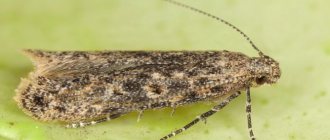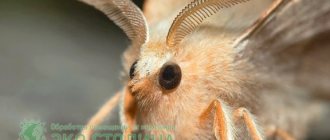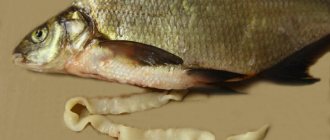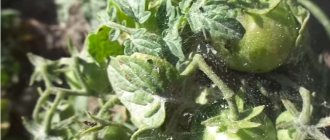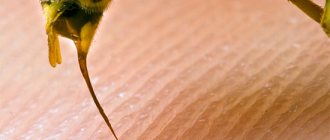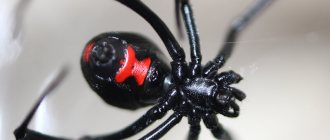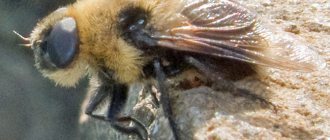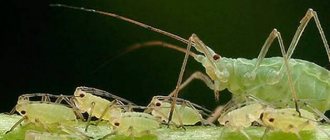This pest has different names: South American moth, Tuta absoluta, leafminer moth. However, the harm they cause is the same. When plantings are infested with this moth, you can lose the entire crop in a couple of days. What kind of pest is this tomato moth, and how to fight it? It is one of the representatives of the family of moths. The wingspan of an adult is gray, 8-10 mm, and the body itself is no more than 7 mm. Despite such small size, this insect causes significant harm.
Photo: Tuta absoluta harms nightshade crops
Control measures in the greenhouse
In modern industry, there are a considerable number of chemical compounds for controlling moths on tomatoes. However, in some cases, gardeners should destroy the pest in the greenhouse using biological methods. What is the best way to fight the parasite? There is no clear answer to the question: it all depends on the abundance of insects and the degree of damage to plants caused by the tomato moth.
Dangerous Tourist: How Travelers Become Mass Murderers
Tuta absoluta is the Latin name for this insect pest that came to our latitudes from the American continent.
Inconspicuous, like all moths, it blends in with its surroundings, making it difficult to detect. This was the reason for the penetration of the South American leaf miner into Europe, both with tomatoes affected by it and on packaging and containers. The tomato moth also travels on other nightshades - potatoes and eggplants. This insect can cover relatively short distances independently with the help of passing air currents. This moth is called a mining moth because it forms so-called mines on various parts of the plant - voids in place of gnawed out parenchymal tissue. Outwardly, they look like patterned spots, and inside these passages there are pupated caterpillars. It is important to differentiate the pest in time, since the description of the mine is similar to damage caused by other insects.
The more favorable the environmental conditions (air temperature within 22-28°C, humidity up to 80%), the higher the likelihood that the pest will multiply extremely actively and, accordingly, devour tomato plantations. If, in addition, there are no natural enemies of the tomato moth, then the likelihood of destruction becomes more than real - especially considering that the females begin to mate almost immediately after leaving the cocoon, and during the season they can make at least 10 clutches of 150-250 eggs each .
This quarantine pest first tasted European tomatoes at the beginning of the 21st century, starting its catastrophic march from Spain. How Tuta absoluta crossed the Atlantic Ocean is unknown, but it was soon discovered in Holland, Germany and other countries of Eastern Europe, and then in the former Soviet republics. And wherever it appeared, the tomato plantings were destroyed at best by half, but more often the absolute mulberry, starved during the journey, attacked the tomato plantations with all mercilessness. And farmers were left to state that their crops were completely destroyed and something needed to be done.
Kinds
There is one type of pest - the South American tomato moth. Representatives of this group are called Tuta absoluta, belong to the Lepidoptera family and originally destroyed the tomatoes of South America. In the 21st century, the insect settled in Southern Europe and reached Russia.
Damage to plants is caused by larvae; adult butterflies are not dangerous to the crop. The parasite bores leaves and fruits. As a result of the active activity of the insect, irregularly shaped “mines” are formed on plant leaves. It is for this reason that the pest is otherwise called the tomato leaf miner. The damaged leaf begins to resemble translucent gauze.
The larva is able to feed on plants throughout the entire period of tomato growth.
Geographical distribution
The tomato leaf miner is a common pest for Central American countries, which in the second half of the 20th century spread to the entire South American continent and the countries of Southern Europe. The tomato moth has been recorded in Bolivia, Brazil, Chile, Colombia, Ecuador, Paraguay, Uruguay and Venezuela, so it can be argued that the insect thrives in regions located at an altitude of less than 1000 m above sea level.
In Europe, the moth first appeared in Spain in 2006, where it is currently the predominant pest of tomatoes. It is necessary to take into account the fact that these countries are today considered the main suppliers of export tomatoes, including Turkey, from where tomatoes are brought to us. Algeria and Morocco, which also regularly supply Russia with this type of vegetable, reported outbreaks of tomato moth in 2008.
Tuta absoluta also grows actively in Italy, France and Tunisia. All European “records” of this insect, to date, have been registered specifically on tomato crops, without signs of damage to other plants.
On the territory of the Russian Federation, the tomato moth was first discovered in 2008, during an inspection of exported products from South America and Turkey. As an established pest, the insect was discovered in the Krasnodar region in 2010. By the end of 2011, tomato moth larvae were already found everywhere by farmers in the Republic of Adygea, Dagestan and Bashkiria, both in open ground and in closed greenhouses. Among the neighboring countries, Belarus, Ukraine and Lithuania are in the high-risk zone.
Life cycle
The development cycle of the tomato moth under optimal conditions lasts for 40 days, which includes 4 stages:
- Egg (oval in shape, cream or yellowish in color).
- Larva. During development, it changes color from yellow to reddish. The caterpillar length is about 7 mm.
- Pupa (brown in color, size 5 mm).
- Adult.
The female can lay up to 3 hundred eggs, placing them on the inner surface of the leaf or on top of the stem. During the daytime, the parasite hides; at night, fertilization and laying take place. In the form of an egg, the insect exists for 7 days.
The life cycle of larval development lasts 15 days. During this period, the caterpillar manages to infect the leaves, stems, flowers, and fruits of the plant. The pupal stage takes 10 days. At this time, the formation of a cocoon occurs. Then an adult appears, which lives only 7 days, however, it actively reproduces.
During a female-dominated season, up to 12 generations of offspring can be reproduced. Under favorable conditions, this most dangerous quarantine pest can destroy more than one tomato plantation.
Signs of defeat
It is not always possible to see the tomato moth due to its small size. Butterflies mainly appear at night, and during the day they hide. Therefore, an invasion can be determined by a number of indirect signs:
- eaten leaves and stems;
- larvae and caterpillars inside tomatoes (green only);
- passages are noticeable on the surface of the fruit;
- bushes lag behind in development;
- complete death of the tops (advanced stage);
- Plants often suffer from fungal diseases; the above-ground parts rot and die.
A tomato fruit affected by a pest can be identified by visual inspection
Important! The tomato moth does not affect ripe, filling tomatoes. If they are the ones who suffered, it is due to other diseases or pests.
How to get rid of tomatoes
The first thing an owner can use in his garden plot is pheromone traps. A pheromone-based trap helps not only to catch parasites, but also to conduct further monitoring. The technique does not kill pests, but only helps to collect them in one place for further destruction.
If we are talking about mass captivity of insects, a modern trap - Qlure-TUA - will help. It is better to give preference to this method of control when the soil is protected. It is not advisable to use the product if the soil is unprotected. The trap will reduce the population of attacking insects. To do this, you just need to place “baits” in strategic areas.
The most effective method is in combination with other methods aimed at combating moths on tomatoes. Pheromone traps are not always available. In this case, an alternative method will come to the rescue - the use of living organisms.
The leaf miner on tomatoes can “boast” of a large number of enemies in nature. Among these representatives are: Macrolophus tais, Trichogramma pretiosum, etc.
These same organisms can easily be used in the garden or greenhouse if the question arises of how to get rid of heart moths on green tomatoes. Trichogramma are the most effective in this regard - they reduce up to 92% of all pests.
Tomato moths and whiteflies on tomatoes are best destroyed with Bacillus thuringiensis. This option will be justified in case of mass accumulation of parasites - when the problem is considered at the state level.
Prevention of occurrence
Preventing the appearance of tomato moth is much easier than dealing with the consequences of its life activity. To do this, experienced farmers and gardeners recommend carrying out the following activities:
- Every autumn, dig up the soil in the greenhouse and in the open ground. Larvae and adult insects of tomato moths overwinter in surface soil, so plowing will not give them a chance to survive.
- It is recommended to observe crop rotation and not grow nightshades (potatoes, tomatoes, peppers, eggplants) for more than 4-5 years in a row.
- Carefully remove the tops and burn them. It is not recommended to use plant residues for mulch or compost - tomato moths and other pests also overwinter in them.
- For prevention, it is better to grow varieties that are resistant to tomato moth. But even in this case, it will not be superfluous to periodically inspect the plantings and carry out treatments with insecticides or folk remedies.
- Disinfect greenhouses after harvesting. Particular attention should be paid to ceilings, connections of frame elements and other secluded places.
- Also, do not forget about periodically loosening and weeding the soil. To prevent the spread of pests, it is recommended to mulch the plantings with dry straw, hay or sawdust.
- Before planting, the seeds are pickled for 30 minutes in a 1% solution of potassium permanganate or any fungicide.
Chemical control methods
Chemical methods of controlling tomato moth are more popular. However, the fight against tomato moths in this case must be carried out very carefully. At the first stage, gentle techniques are used. If they do not give the desired result, you can move on to the “heavy artillery” - spraying tomatoes with preparations based on pyrethrum. You can also use an aqueous solution of the drug.
The spraying procedure for poisoning tomato moths or whiteflies on tomatoes is carried out no more than 6 times with intervals of several days. It is recommended to follow the prepared schedule.
Attention! Frequent use of insecticidal preparations leads to the development of resistance to the composition by insects.
Among the long-acting active substances that are effective in the fight against insect larvae are: Deltamethrin, Imidacloprid, etc. The named insecticides against tomato moth can be used exclusively for treating leaves; fruits that absorb the substances through the formed “mines” will harm the human body.
Chemical treatment against tomato moths can harm not only the parasites, but also the gardener.
To avoid unpleasant consequences, the following safety precautions should be followed::
- use gloves and a mask to protect exposed skin;
- Carry out the procedure in the morning or evening with minimal insect activity;
- carry out processing no more than 6 times, taking breaks of several days.
However, the question of how to get rid of moths is not closed. The fact is that the larvae of parasites are tenacious and after getting into the soil (when etched) they can continue to develop . In this case, we are talking about a severe infection - aqueous solutions of preparations based on pyrethrum will come to the rescue, which the gardener will have to pour onto the beds.
The scheme for using drugs in the process of getting rid of moths involves using the drug using one of the following methods:
- spraying plant leaves;
- adding the solution to the soil;
- injection into the trunk.
The first method is the safest and most accessible. Chemicals should only be introduced into the soil as a last resort, as they may be absorbed into the tomatoes. The same applies to injections into the trunk.
“Tuta absolute” is a tomato leaf miner or South American moth.
04/20/2017 Title “ mining moth”
"(lat.
Tuta absoluta
) comes from the ability of the insect larva (caterpillar) to gnaw tunnels in nightshade crops and feed on the mesophyll of plant tissue, while leaving spots (mines) on the plant that resemble patterns. Damaged leaves, buds, stems, flowers and even fruits in places with eaten away parenchyma are completely covered with mines.
The base plant for tut absolute
is a tomato.
In favorable climatic zones, with an abundance of food and the absence of natural enemies, this insect can cause up to 100% damage, destroying the entire tomato crop, so pest control is extremely important. The tomato leaf miner
is recognized throughout the world as one of the most dangerous quarantine insects.
quarantine insect
Title " quarantine"
“The pest “deserves” due to its particular harmfulness, since when it finds conditions favorable for life, it begins to multiply en masse and, having no natural enemies in its new habitat, becomes a real disaster, causing significant damage to farms where tomatoes are grown.
Despite the fact that the system of mandatory quarantine measures includes strict adherence to transportation rules and inspection of seed materials and seeds, the pest still manages to cross state borders and, together with tomatoes, eggplants, potatoes and other nightshade crops, conquer new territories.
The homeland of mulberry absolute
is South America. It took the pest approximately five centuries to cross the Atlantic Ocean and reach Europe. In 2006, the insect was brought to Spain. Rapidly multiplying colonies of the South American tomato moth began to literally destroy entire tomato plantations, which is why they created an economic threat to the country as a whole.
Following Spain, the harmful mulberry of the absolute
was discovered in the Netherlands, where it arrived along with tomatoes and packaging containers.
In 2009, the pest was first recorded in Germany, Belarus, the Russian Federation and the Czech Republic.
The South American tomato moth arrived in Ukraine in 2010 along with a shipment of tomatoes from Turkey and Syria. In this regard, a temporary ban was introduced on the import of tomatoes, peppers, eggplants and potatoes into the country. Urgent measures were taken to localize and eliminate all outbreaks of the quarantine pest: chemical treatment of the entire infected area, burning of tomato tops, subsequent careful disking and deep plowing of the soil.
Then, thanks to the actions taken, the massive spread of the pest was briefly delayed.
By the beginning of 2012, the moth had already been registered in more than fifty-six countries in Europe, North America, and the Near and Middle East.
In many countries there is no absolute
has the status of a quarantine insect, since the situation with the rapid spread of tomato moth creates a danger for the development of the food sector. The appearance of this pest causes concern and concern among agricultural managers, farmers and everyone involved in the cultivation of nightshade crops.
Despite the measures taken, from time to time colonies of the South American leaf miner appear in various regions of our country.
Adult insect (imago)
Tuta of absolutes
belongs to the family of moths. It has an elongated body about 5–6 mm long. The wingspan is up to 1.5 cm. The wings are gray on top and have an inexpressive pattern of brown or beige-reddish hue. Males are slightly darker than females.
The main plant in which the pest lives and feeds is the tomato, although it can feed on eggplants, potatoes, and peppers.
Adults are most active at dusk or early morning. During the day, insects hide from the scorching sun in the leaves and stems of tomatoes.
Mating of individuals occurs early in the morning, as soon as new adults are born from the pupa.
Under favorable conditions there is absolute
can produce up to 10–12 generations per year, which is a very high fertility rate.
The insect colony is mainly dominated by females, who lay an average of 150 to 260 eggs on nightshade crops during their lifetime.
Egg
The egg of the tomato moth looks like a cylindrical ellipse, small, bright white. As the larva develops and grows, the egg acquires a yellowish and subsequently brown color.
Larva
The larva (caterpillar) of the tomato moth goes through four stages (or phases) of development.
Newly emerged larvae are small in size (approximately 0.5 mm). The shape of the body is cylindrical. The larva has three pairs of legs. On the back of the head of the gradually maturing caterpillar, which protrudes from the body, a black stripe appears, bordering the body. As the larva grows and develops, the initially yellowish color of the body acquires a greenish tint.
In the adult caterpillar stage, the insect reaches a length of 1 cm, and its back acquires a pinkish tint.
The larvae damage plants of any age, be it seedlings or an adult bush, feeding on leaves, stems, flowers, buds and even infecting fruits, sometimes penetrating deep inside tomatoes.
A characteristic sign of damage to a tomato, as mentioned above, is the presence of mines on the plant in the form of spots, inside of which there are larvae of the South American moth.
Doll
The caterpillar pupates while in the soil or living on a plant (in a mine). The pupal stage lasts approximately 10 days. The pupa can reach a length of 1.5 cm. It has a greenish color, and by the final phase of its development it becomes brown.
The insect can overwinter at any stage of its development (egg, larva, pupa or adult), which makes it difficult to control.
Battle for the Harvest
Fighting the absolute tutta
It is difficult for insects to quickly develop resistance (resistance, immunity) to chemicals. Despite the fact that entire scientific institutes in a number of countries have been dealing with the problem of the spread of harmful moths for decades, it is still winning on all fronts. In the fight against this malicious pest, many different chemicals and preparations (insecticides) have been developed and tested, but a reliable and guaranteed result has not yet been achieved.
The destruction of the pest is complicated by the fact that the insect leads a secretive lifestyle. It is either in the ground (where the pupation process most often occurs) or inside the stems, leaves, and fruits, which also seriously reduces the effectiveness of treating an infected plantation with pesticides.
As a result, plant protection specialists came to the conclusion that it was necessary to develop an integrated pest control system that would include comprehensive protection of nightshade crops in several countries at once. An important place in this strategy for combating South American moths should be given to thoughtful agrotechnical techniques in combination with the use of the most effective insecticides.
Preventive methods of pest control
Considering the extreme fertility and harmfulness of the mulberry absolute moth,
Thorough destruction of moth-damaged plants should be an integral part of the control strategy.
The lion's share of tomatoes (about 90% of all products consumed in Ukraine) is grown in private and household plots, in small greenhouses, and in vegetable gardens.
Gardeners need to remember that in winter, due to freezing of the soil, the majority of pests die, but insect larvae and pupae can survive on packaging containers, on work equipment, and even on clothing. When, together with these items, they find themselves in a warm, heated room, they get an excellent opportunity to survive the winter safely.
In addition, warm winters “play into the hands” of pests, allowing the insect population to survive this difficult period. Therefore, gardeners are strongly recommended, immediately after harvesting tomatoes, to carefully remove all remnants of vegetation (tops) from the site, which can become a protection and home for pest pupae.
Greenhouse owners are recommended to carry out mandatory seasonal disinfection of ceilings, frames and places where insects can hide.
Agrotechnical control methods
Upon completion of harvesting tomatoes and other plants of the nightshade family, it is necessary to carry out thorough mechanical cultivation of the soil (cultivation and deep plowing of the soil) in order to destroy the pest pupae.
It is also necessary to constantly change plantations for nightshade crops and carefully remove all plant debris after harvesting.
An equally important agricultural technique is the timely feeding of plants with mineral fertilizers.
Biological control method
In the countries of South America, where the tomato moth comes from, a fairly effective way to combat the pest is the use of pheromone traps.
It has been noticed that if the number of males on a plantation is sharply reduced, then a massive reduction in the entire insect population occurs.
For the mass capture of male moths directly in a tomato field, it is practiced to install a sufficiently large number of traps treated with pheromones (about 20–25 pieces per 1 hectare of area).
In many countries, farmers successfully use the pheromone " Qlure-TUALD
" and "
TUA-Optima
".
Use of predatory entomophages
In its homeland, the tomato moth has always had natural enemies. In total, there are more than fifty species, among which a special place is occupied by predatory bugs, eulophid parasites (feeding on pest eggs), as well as entomopathogenic bacteria.
Special breeding of the most promising natural enemies is a very promising direction in the fight against tomato moth.
Chemical control methods
Previously, phosphorus compounds were used as chemicals to effectively control tomato moths, but due to their high toxicity, their use had to be abandoned.
Currently, the most effective chemical insect control agent is the use of abamectin
and
chlorfenapyr
, which contribute to the destruction of larvae (up to 100%), since their action is aimed at blocking and suppressing the most important vital systems of the pest.
Extracts of tropical plants of the Meliaceae family are used as insecticides of plant origin against moths: Trichilia pallens
) and neem tree (lat.
Azadirachta indica
).
Of the most effective and popular imported drugs, the following are used: “ Coragen
"(has a long-lasting protective effect), "
Avant
" (withstands high ambient temperatures) and "
Prokleym
" (does not wash off with rain, but is afraid of ultraviolet rays).
Treatment with insecticides must be carried out during the period of mass oviposition and the birth of larvae (every ten to fifteen days).
However, it must be remembered that there is no single effective remedy for combating tomato moths. None of the available drugs is yet able to completely destroy the pest. Consequently, under favorable conditions, it is capable of instantly restoring the population due to its incredible fertility.
But it is not all that bad. Despite the fact that this pest appeared quite recently and is still poorly understood, many practitioners involved in growing tomatoes find quite effective ways to combat mulberry absolute
.
Thus, one of our regular readers, who is involved in greenhouse farming, shared his experience of successfully getting rid of leafminer moths, for which we are very grateful to him. He uses permethrin smoke bombs to disinfest greenhouses.
Pyrethroid drugs, which include permethrin, have a wide spectrum of action and are capable of destroying a wide variety of insects and mites. At the same time, they have a direct effect on the nervous system of pests, causing paralysis, which results in death.
In addition, upon direct contact, permethrin kills not only adult insects, but also eggs and larvae.
Pyrethroid preparations in the form of smoke bombs are produced specifically for use in enclosed spaces - warehouses, utility rooms, service areas, as well as greenhouses.
But they must be used strictly according to the instructions, ensuring the number of blocks corresponding to the volume of the greenhouse, its tightness and the required exposure time. Only in this way can high processing efficiency be achieved. Share on social networks:
Folk remedies in the fight against the parasite
In addition to the main method of pest control, you can use several folk recipes:
- Mustard oil. Plant leaves should be treated with the composition on both sides.
- Rapeseed oil. Use a similar method.
- Orange (fresh or essential oil). The insect does not like the aroma of citrus fruits. You can scatter orange peels on the beds or spray oil.
- Lavender. It is recommended to plant a lavender bush in a pest-free greenhouse or simply hang bunches of flowers from the plants.
- Mint. You can start arranging beds with mint inside the greenhouse or simply hang dried grass.
The nuances of getting rid of midges
The choice of the most preferable methods of pest control will largely depend on where the pests are found - on plants planted in open ground or in a greenhouse.
In the open ground
To get rid of small midges, a combination of insecticidal treatment and folk remedies is most suitable. It is best to use a biological product that contains natural ingredients that are safe for people and animals.
Control measures in the greenhouse
To get rid of moths in a greenhouse, it is not recommended to use insecticides. In a confined greenhouse, it is effective to use traps, biological methods, folk remedies, and fumigation.
Fumigation of greenhouses
To prevent pests from growing on tomatoes in a greenhouse, the fumigation method is used. All the windows are closed and the cracks are plugged. One or several (depending on the area) smoke bombs are placed inside the greenhouse. The checkers are set on fire and left inside the room, closing the door tightly. After 1-2 days, the greenhouse must be thoroughly ventilated.
Seedling protection
In order to protect seedlings from infection, it is necessary:
- treat the soil before planting;
- maintain distance when planting plants;
- Before planting, carefully inspect each bush.
If the seedlings were purchased in a store or market, they must be quarantined for 10 days.
Popular questions
Is cucumber affected by tomato moth?
The pest feeds exclusively on members of the nightshade family. Cucumber is not included in this group. Conclusion: individuals do not mine cucumbers, they are only dangerous for tomatoes.
Is it possible to eat tomatoes damaged by tomato leaf miner?
Damaged fruits can be eaten provided there is no toxic treatment of the plants, which was carried out several days earlier. Damage to a tomato can simply be cut out.
Thus, the tomato moth is a serious pest of the tomato crop. In a short life cycle, an insect can give birth to several generations of pests.
The parasite damages not only plants, but also fruits - the leaves take on the appearance of transparent gauze, and “mines” appear on the tomatoes.
There are two types of methods to combat parasitic organisms:
- Gentle methods - biological
- and chemical ones are more radical.
The second group of methods, despite the high level of toxicity, is more popular.
What harm does
The tomato moth got its name due to the fact that it causes great damage to these particular plants. Farmers and gardeners note that crop losses due to severe infestations can amount to more than 50%, often up to 100%.
Insects feed on the leaves, destroying all mesophilic tissue and leaving only the epidermis (the superficial transparent layer). The main damage is mines in the form of characteristic spots. It is in them that the larvae leave their excrement. Gradually the affected area turns brown and dies.
In this case, the tomato moth larvae leave the mines and spread to other parts of the plant. They are able to penetrate quite deeply into young cuttings, as well as fruits. Accumulations of dark excrement are visually visible on the drilled holes. In this case, even slightly damaged fruits can only be thrown away. They are unsuitable not only for sale, but also for personal consumption.
